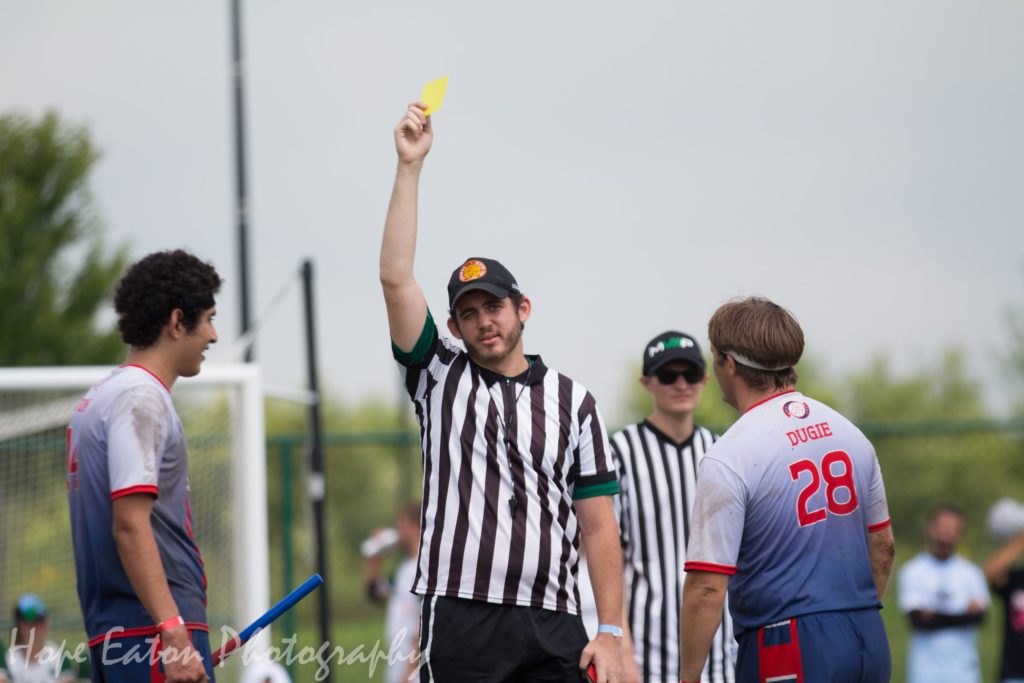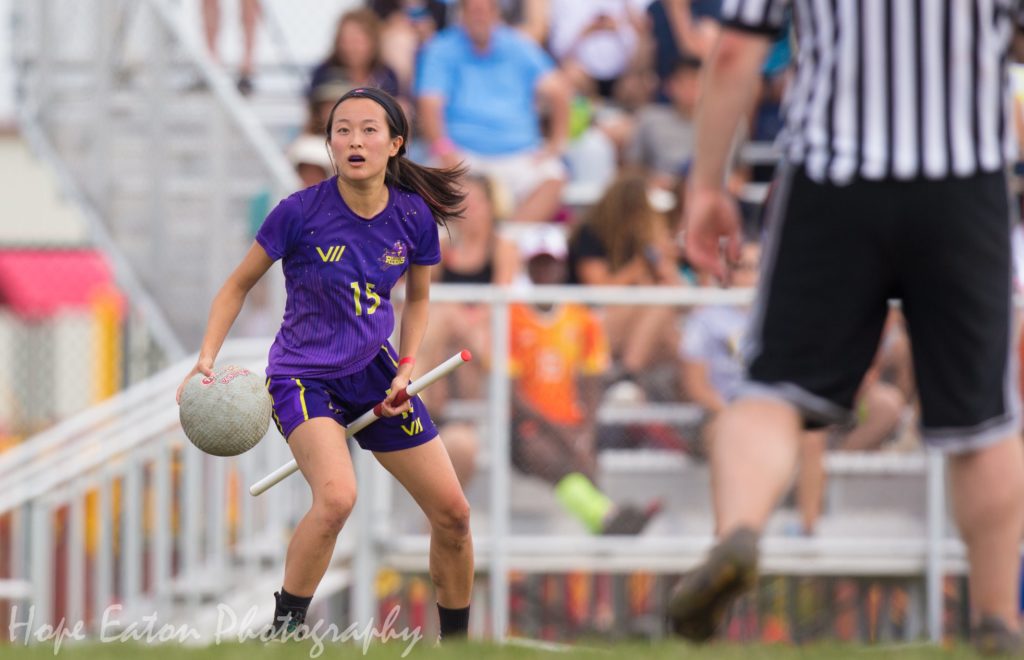Antwerp QC, Much of Belgian Core, Leaves Competitive Quidditch

Credit: Hope Eaton
With each new season, the young sport of quidditch makes new adaptations. There are changes to the strategy on pitch, the training and events, but perhaps the most historically significant changes are made to the rules. While the removal of capes is arguably the biggest change in our short history, each rendition of the rulebook has left its own mark on the game.
This season, USQ unveiled Rulebook 12 and with it, three eye-catching changes that will influence strategies this season and beyond—assuming the rules remain. Rulebook 12 also includes some structural changes that will make the sport easier for volunteers and be another stepping stone toward legitimization.
You Can Copy My Homework, Just Make it Look Different
“The pitch shape has been changed to a 36 x 66 yard rectangle.” – Pg. 175, Section 2.2.1
“The starting line has been moved to the keeper zone line.” – Pg. 177, Section 3.2.1
“Each team gets one one-minute timeout per game. Timeouts may only be called during pre-existing stoppages.” – Pg. 175, Section 3.3.4
Last year, USQ announced their own version of the reset rule that MLQ had implemented in 2017. This year, too, USQ appears to be copying the model set by MLQ. USQ has decided to remove the starting line, alter the pitch dimensions and introduce timeout rules–all of which were changes previously made by MLQ (although USQ has added their own twists).
The removal of the starting line just means that brooms up will begin from the keeper line. Gameplay-wise, you could argue that this will help players’s acceleration but referees and volunteers will reap the real benefit: one less line to mark and track. USQ also got rid of the pill-shaped soft boundary. MLQ altered the soft-boundary, but they only made it a rectangle; they did not remove it entirely. The boundary was easily the most challenging part to mark on a pitch and was therefore inconsistently marked and enforced.
The aforementioned changes are very smart moves for the sport for a number of reasons. With pitches now easier to mark, tournament directors and referees will be able to focus more time on other, more important tasks like schedule and gameplay. On pitch, the rule eliminates a very ticky-tacky call that results in pointless turnovers when the quaffle ends up out of the pill-shaped boundary (which, again, are often poorly-marked and not consistently enforced).
On a larger scale, the change allows for a better spectator experience. It normalizes the game by restricting it to a more traditional play area and will make the game more digestible for new fans. It’s easier to market a unique new sport when there are fewer barriers to understanding the game.
In addition to the changes to the pitch, USQ has also added a one-minute timeout than can be used during regulation play. Unlike in MLQ, this timeout can only be used during a stoppage of play (for an injury or penalty, for example). The timeouts will work much like they did during the first season of MLQ: some teams will come prepared to use them, others will figure it out as they go, some won’t use them at all and many will forget they even exist.
The teams who do utilize the timeout will help refine the game of quidditch further. Teams will have time to work out counter-strategies in-game. Coaches will be able to communicate specific game strategies to the entire team at once, instead of only to whomever happens to be on the sideline at the time. And, unlike MLQ timeouts, these timeouts are less likely to be abused to quell momentum since they have to be called during a stoppage. Instead, timeouts will most likely be employed more to attack or defend during power plays that come with penalties.
Off-Pitch Procedures are Less Than Pitch-Perfect
“Forcing ball carriers over the pitch boundary to force a turnover is now legal.” – Pg. 176, Section 7.5
With the new pitch dimensions comes a new set of rules. The biggest two changes include a stationary inbound procedure and the ability to create a turnover by physically forcing your opponent out of the hard boundary.
The inbounding procedure is going to look a lot like the one in basketball. For both bludgers and quaffles, the inbounding player gets a five-second countdown (during which they are immune) to get the ball into play. They can get the ball into play via a pass or by running it back onto the pitch. There are already a number of issues with reffing bludgers that go off-pitch and this could help to moderate that. More strategy will derive from the quaffle and we can expect to see teams run set plays to get the ball or even attack the hoops during their five-second window.
The ability to drive a player off-pitch to create a turnover should shake up team strategies significantly. Teams will need to have more refined passing attacks as it will be more dangerous to play along the boundaries. Defensively, it diminishes the need to tackle the ball carrier, as a wrap and drive can actually create a turnover where a tackle cannot. With play being safer in the middle of the pitch, though, the ability to open-field tackle will be used more.
While the first section of rules addressed in this article should ease some stress for volunteers, this rule will increase it equally, at least. Spectators around the hard boundary will need to be regulated at all times, as many players will try to check opponents with balls off pitch.
The rule introduces potential for new strategies, but the safety concerns may outweigh the positives.

Credit: Hope Eaton
Changing of the Guard(ing)
“…throwing one’s bludger over the head of the opponent and to their hoops no longer allows the throwing beater to pick up the third bludger” – Pg. 175, Section 5.5.1
“The penalty for third bludger interference (replacing the term “guarding”) is now the turnover of two bludgers in addition to the back to hoops penalty.” – Pg. 175, Section 5.5.1
Just like the earlier rule changes will undoubtedly alter quaffle play, these new rules should shakeup standard strategy for beaters. At the elite level, the new limitations to bludger interference and immunity will not drastically change the beating game. Beaters like Jackson Johnson, Max Havlin or Lulu Xu already practice using the third bludger this way. But most beaters do rely on throwing the third bludger towards their opponent’s hoops. As less-refined beaters learn to implement this strategy, expect many to lose bludger control from the growing pains. However, once beaters adjust overall, we will see more fast breaks in the quaffle game, and more and more beaters blowing up offenses while extending their team’s no-bludger situation.
By the end of the season, the top teams should have very specific ways to deal with this new bludger rule. As the strategy saturates, however, these attacks will lose effectiveness as they become more common. Seeing the rule in action throughout the season will force teams to strategize about where they want the quaffle to go, how they should defend against it and who they’ll want running down the bludger.
One side-effect of this rule: it could be a nightmare for referees. Many will be forced to make judgement calls on whether or not the beater was throwing at someone. Since these calls will come from assistant referees, it puts a hefty burden on some of the most unqualified volunteers on pitch.
Overall, these rules will be a good addition to the game. Each will make it more consumable for a larger audience while not taking away much from the flow of the game for those who have been playing for years. Implementation will likely be rough at first as some of these rules are a pretty hard shift from where the previous rulebook. When members of the community do get acclimated expect a more enjoyable game of quidditch.
Archives by Month:
- April 2025
- May 2023
- April 2023
- April 2022
- January 2021
- October 2020
- September 2020
- July 2020
- May 2020
- April 2020
- March 2020
- February 2020
- January 2020
- December 2019
- November 2019
- October 2019
- August 2019
- April 2019
- March 2019
- February 2019
- January 2019
- November 2018
- October 2018
- September 2018
- August 2018
- July 2018
- June 2018
- April 2018
- March 2018
- February 2018
- January 2018
- November 2017
- October 2017
- July 2017
- June 2017
- May 2017
- April 2017
- March 2017
- February 2017
- January 2017
- December 2016
- November 2016
- October 2016
- September 2016
- August 2016
- July 2016
- June 2016
- May 2016
- April 2016
- March 2016
- February 2016
- January 2016
- December 2015
- November 2015
- October 2015
- September 2015
- August 2015
- July 2015
- June 2015
- May 2015
- April 2015
- March 2015
- February 2015
- January 2015
- December 2014
- November 2014
- October 2014
- September 2014
- August 2014
- July 2014
- May 2014
- April 2014
- March 2014
- February 2014
- January 2014
- November 2013
- October 2013
- September 2013
- August 2013
- July 2013
- June 2013
- May 2013
- April 2013
- March 2013
- February 2013
- January 2013
- December 2012
- November 2012
- October 2012
Archives by Subject:
- Categories
- Awards
- College/Community Split
- Column
- Community Teams
- Countdown to Columbia
- DIY
- Drills
- Elo Rankings
- Fantasy Fantasy Tournaments
- Game & Tournament Reports
- General
- History Of
- International
- IQA World Cup
- Major League Quidditch
- March Madness
- Matches of the Decade
- Monday Water Cooler
- News
- Positional Strategy
- Press Release
- Profiles
- Quidditch Australia
- Rankings Wrap-Up
- Referees
- Rock Hill Roll Call
- Rules and Policy
- Statistic
- Strategy
- Team Management
- Team USA
- The Pitch
- The Quidditch Lens
- Top 10 College
- Top 10 Community
- Top 20
- Uncategorized
- US Quarantine Cup
- US Quidditch Cup
